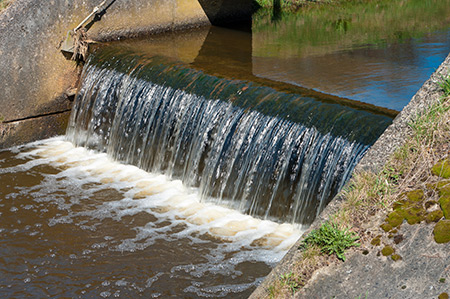
When assessing the sustainability of a substance like a surfactant all the influences and impacts throughout its complete life-cycle, from production to use and through to final disposal, need to be considered.
With the help of life-cycle assessments and eco-footprint methods the surfactants industry is able to determine not only the eco-relevance of the surfactant itself but also its positive impact on the end-to-end value chains where it is used.
Sustainability in manufacturing: natural or synthetic raw materials
more sustainable just because the raw material source is renewable?”
A key discussion related to the sustainability of surfactants focuses on the raw materials used in their manufacture. Surfactants can be made using raw materials derived from both natural (bio) or synthetic (petrochemical) feedstock, or a combination of the two.
 Natural surfactant feedstock comes from a renewable source such as palm kernel oil while synthetic feedstock is derived from fossil fuel, as a result of crude oil refining and petrochemical processing. But can it always and automatically be claimed that a surfactant is more sustainable just because the raw material source is renewable? Again, further criteria needs to be recognised and all aspects of the surfactant life-cycle considered, and the issues can be wide-ranging and complex.
Natural surfactant feedstock comes from a renewable source such as palm kernel oil while synthetic feedstock is derived from fossil fuel, as a result of crude oil refining and petrochemical processing. But can it always and automatically be claimed that a surfactant is more sustainable just because the raw material source is renewable? Again, further criteria needs to be recognised and all aspects of the surfactant life-cycle considered, and the issues can be wide-ranging and complex.
For instance, some types of surfactants that are crucial to products or processes with positive sustainability credentials, such as a low carbon footprint, can only be produced using synthetic raw materials. On the other hand, natural feedstocks have other sustainability issues to take into consideration relating to land use, social aspects and crop protection. Renewable resources typically require increased use of fertilisers and pesticides while making land available for growing the crops often involves the clearing of natural forest or a switch away from food production.
 So when it comes to the sustainability of raw materials, the surfactant industry’s focus is on developing better and more complete scientific understanding of the impact of different feedstock sources on products over their life-cycle, and on optimising the selection of raw material for production. CESIO has actively contributed to the development of standards that define and measure bio-based surfactants – those that to a certain extent are produced on the basis of renewable resources – in order that more meaningful comparisons decisions taken based on a scientific approach.
So when it comes to the sustainability of raw materials, the surfactant industry’s focus is on developing better and more complete scientific understanding of the impact of different feedstock sources on products over their life-cycle, and on optimising the selection of raw material for production. CESIO has actively contributed to the development of standards that define and measure bio-based surfactants – those that to a certain extent are produced on the basis of renewable resources – in order that more meaningful comparisons decisions taken based on a scientific approach.
There is no single ‘one size fits all’ pathway and as a result surfactant producers typically utilise both synthetic and natural feedstocks in their production, either separately or in combination. Today, around 50% of surfactants in Europe have at least one constituent from a renewable feedstock.
See also How surfactants are made
Sustainability in use: efficient and safe applications
 The technical performance of surfactants plays a key role in enabling many applications, and their value chains, to become more sustainable. Smart surfactants can dramatically improve the overall sustainability of a value chain by promoting process efficiency and the use of fewer overall resources, whether energy, water or other materials, and often reducing levels of more hazardous components required.
The technical performance of surfactants plays a key role in enabling many applications, and their value chains, to become more sustainable. Smart surfactants can dramatically improve the overall sustainability of a value chain by promoting process efficiency and the use of fewer overall resources, whether energy, water or other materials, and often reducing levels of more hazardous components required.
Some examples where surfactants make a positive contribution to sustainability include:
- In household cleaning: surfactants have played a decisive role in making almost all household cleaning jobs easier while providing greater hygiene, appearance and protection of the surfaces cleaned and reducing the need for more hazardous chemicals
- In laundry detergents: smarter surfactants enable dirt and grime to be removed at lower washing temperatures - even in cold water - hence reducing energy and fossil fuel consumption used in the process.
- In insulation production: surfactants are key to the efficiency of manufacturing processes employed in the production of foam to make insulation boards and blocks that reduce the energy needed to heat and cool buildings.
- In industrial chemical processing: spraying surfactant solutions onto powdered chemicals, for example, the latter can be processed more effectively and more safely.
- In shampoo, liquid soaps and shower gels: surfactants are essential constituents of these formulations both for mobilising dirt but also allowing the foam to be easily rinsed off using the minimum amount of water.
- In crop protection: surfactants prevent spray solutions from rolling off the leaf surface, enable uniform dispersion of the active substance on the leaf and thus increase the effect of the agents used – the farmers can achieve the same protection using less chemicals.
Sustainability in disposal: biodegradability
As a significant proportion of surfactants are released into the water system after their intentional use, biodegradability has been a critical factor in assessing environmental compatibility.
 Today, surfactants used in Europe for applications relevant to water quality clearly need to be readily biodegradable or they would have limited market opportunities.
Today, surfactants used in Europe for applications relevant to water quality clearly need to be readily biodegradable or they would have limited market opportunities.
The biodegradation of an organic substance, such as a surfactant, is a natural process that is induced by microorganisms such as bacteria or fungi. They transform the organic substance into endogenous or degrade them to simple inorganic compounds such as carbon dioxide, water and mineral salts.
The origin of the raw material is however not relevant to the biodegradability.
Under European legislation the biodegradability requirements for surfactants used in detergents and cleaning agents have been tightened in several steps with the aim of recycling all chemical elements of a surfactant in the natural material cycle. Since 2005 EU regulation only allows the use of readily biodegradable, completely degradable, surfactants.
Sustainable future
Many of the sustainability issues related to surfactants in the past have been addressed through the close cooperation between legislators, scientific community, regulatory authorities and the industry.
This is an ongoing process, however, and the surfactant industry believes it still has an important further contribution to make to sustainability through continuous innovation and potential for more intelligent, tailor-made surfactant solutions.

